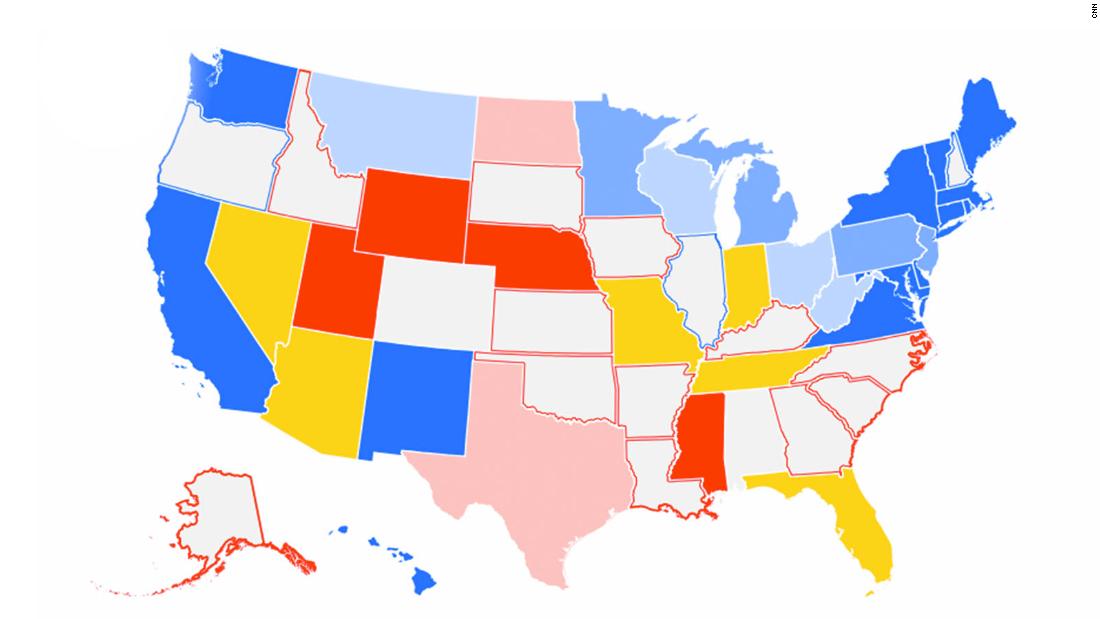
While the battle for the House majority looks to be moving Democrats' way, the fight for the Senate remains less predictable -- largely due to the clash between a national political environment that favors Democrats and a national map that is clearly tilted toward Republicans.
Yes, President Donald Trump was at 36% job approval in the last CNN-SSRS poll. But 10 Democratic senators are up in states that Trump carried in 2016 -- including five in which he won by double digits. It's a clash between an unstoppable force (the political climate tends to always rule) and an immovable object (the electorates in the key Senate battlegrounds are naturally inclined to support Republicans).
One will crush the other. But at the moment, it's very, very hard to tell which one.
As we approach the home stretch before voters make their choices, will the "blue wave" sweep through states Trump won in 2016? Or will the bitter partisan battle over Brett Kavanaugh's Supreme Court nomination fire up the GOP base enough to hold it off?
Senate Majority Leader Mitch McConnell explained the stakes for his party clearly last month: "On the Senate side, I'll just list you a bunch of races that are just dead even: Arizona, Nevada, Tennessee, Montana, North Dakota, Missouri, Indiana, West Virginia, Florida. All of them too close to call and every one of them like a knife fight in an alley. I mean, just a brawl in every one of those places. I hope when the smoke clears, we'll still have a majority in the Senate."
Below, I've laid out five plausible scenarios for how the Senate map could look on November 7, 2018.
Scenario #1: Republican best case (R+3 seats)
Republicans lose a GOP seat in Nevada but hold Tennessee, Texas and Arizona. Republicans win Democratic seats in Florida, Indiana, Missouri and North Dakota.
Nevada has always been the most glaring problem for Republicans in this election cycle. Sen. Dean Heller (R) is in his first term and polling suggests he hasn't made much of an impression on voters. Plus, he's the only Republican running in a state Hillary Clinton carried in 2016.Given all that, Republicans would be absolutely overjoyed to lose only Nevada from their side of the ledger on election night.
As the election cycle has worn on, the cone of true Republican pickup opportunities has narrowed. At the moment, North Dakota looks to be their best bet, with Sen. Heidi Heitkamp (D) struggling to overcome the state's strong conservative tilt. Missouri and Indiana, two states Trump won by double digits, look to be margin-of-error races at the moment. And in Florida, Gov. Rick Scott's (R) heavy personal spending has made Sen. Bill Nelson's (D) political life very uncertain.
Scenario #2: Democratic best case (D+3)
Democrats lose only one incumbent -- Heitkamp (D) -- and clean sweep their four GOP pickup opportunities, with Texas and Tennessee looking like the tougher two wins.
There's a case to be made that on the absolute best night for Democrats even Heitkamp could hold on -- given that she's shown an ability to win close before. But make no mistake: This map -- even with a loss in North Dakota -- would be something close to Democrats' wildest dreams. Arizona and Nevada are both toss-ups that could go either way. In Tennessee, Democrats recruited the only candidate that could possibly win the seat in former Gov. Phil Bredesen. In Texas, Rep. Beto O'Rourke's massive fundraising and the grassroots energy stirred by enthusiasm for his candidacy/hatred for Sen. Ted Cruz within the Democratic base has put the state in play. The underlying partisanship of both states, however, means that Democrats would have to be having a VERY good night to sweep both.
Scenario #3: A great night for Democrats (D+2)
Democrats lose Heitkamp but win GOP seats in Arizona, Nevada and Tennessee.
Again, Heitkamp feels like a goner (or close to it). And it would be somewhat tough to imagine Tennessee and Texas falling to Democrats. Tennessee -- because of Bredesen --feels like the more likely Democratic pickup to me if you forced me into choosing between it and Texas.
STILL, this scenario would put Democrats in control of the Senate, which they need a pickup of two seats to win back. Which was unthinkable at the start of the 2018 election.
Scenario #4: A wash (No net gain or loss)
Republicans lose their two most vulnerable seats in Arizona and Nevada. Democrats lose their two most vulnerable seats in North Dakota and Florida.
Of all the scenarios, this one feels like the most likely to me. (I could also see Republicans holding onto Arizona narrowly for a net one-seat gain.) Nevada isn't a done deal for Democrats but the state's demographics and Trump's unpopularity make it a tough hold. Ditto North Dakota on the other side. Scott feels like a slight favorite to me in Florida and the splits within the GOP in Arizona play in Rep. Kyrsten Sinema's favor.
Scenario #5: Tie! (D+1)
Republicans lose in Arizona, Nevada and Tennessee but win Democratic-held seats in Florida and North Dakota.
This outcome -- which is totally plausible -- would make the Senate divided 50-50 between Republicans and Democrats (and independents who caucus with Democrats). Republicans would still hold the upper hand in the chamber because Vice President Mike Pence would be available to break ties. But it would set off an furious attempt to recruit party-switchers (Joe Manchin! Susan Collins!) as both parties jockeyed for the seat they would need to seize control.
Bagikan Berita Ini














0 Response to "5 ways the fight for the Senate majority could turn out"
Post a Comment